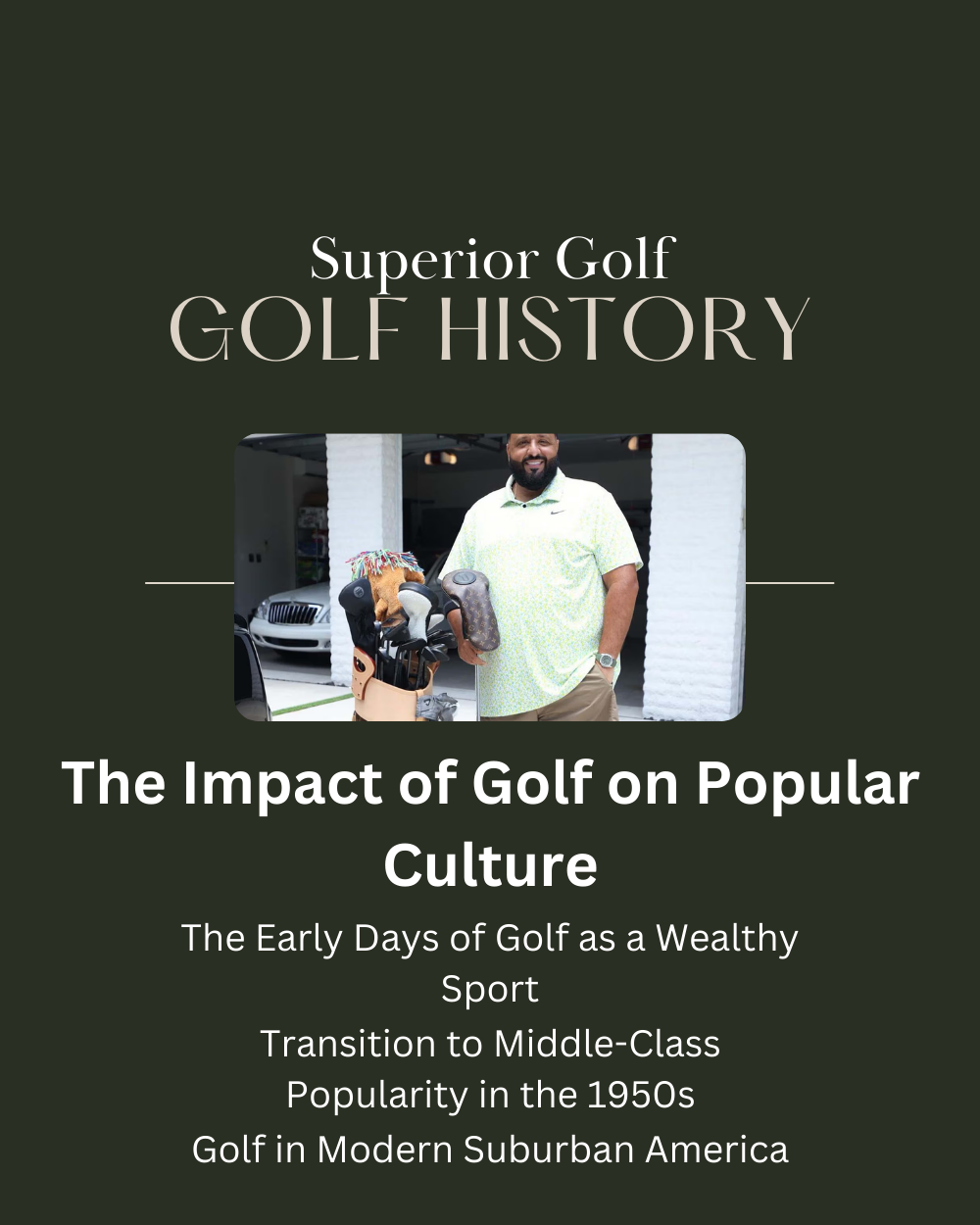The Impact of Golf on Popular Culture: Golf’s story in America is one of elegance, open doors, and wide appeal. It came from the Scottish Highlands, first played by the rich. Yet, it has made its way to be loved by everyone1. Throughout the 20th century, golf went from elite to a sport for all2. Art like Penrhyn Stanlaws’ “Woman in Sandtrap” and Amos Sewell’s “This Car Needs Washing” show how golf became a favorite for many2. This change highlights how golf shifted from a sign of luxury to a part of everyday life and business2.
In the 1920s, Saturday Evening Post covers showed golf as a sport for the well-off. By the 1950s, it turned into a pastime for everyone2. It went from pros at clubs to everyday people at ranges2. John Falter’s 1952 cover paints a picture of people from all walks of life enjoying golf after work2. Amos Sewell’s 1953 cover adds humor by showing a man picking golf over housework. It’s a fun nod to how golf won over many hearts2.
Key Takeaways
- Golf in the United States began as a sport for the wealthy before becoming popular across all social classes2.
- Saturday Evening Post covers illustrate golf’s shift from a luxury sport in the 1920s to a casual activity in the 1950s2.
- The transformation from professional country club players to middle-class enthusiasts practicing at driving ranges underscores its broad appeal2.
- John Falter’s 1952 cover captures the diverse demographic practicing golf2.
- Amos Sewell’s depiction of a husband prioritizing golf over chores symbolizes the sport’s integration into everyday American life2.
The Evolution of Golf in America
Golf in America started as a luxury sport. It was seen as a game for the rich, played at private clubs. It came from Scotland and was all about wealth and privilege. Only the wealthy could enjoy the green fairways, showing off their high social standing.
The Early Days of Golf as a Wealthy Sport
Golf entered America as a rich sport just like other luxurious activities. It was first played in country clubs and was part of the rich culture. When the St. Andrew’s Golf Untitled in Westchester was opened by Charles Blair Macdonald in 1888, it stressed these points3. The clubs maintained Scottish traditions, focusing on being exclusive.
Transition to Middle-Class Popularity in the 1950s
In the 1950s, golf wasn’t just for the rich anymore. It turned into a popular activity for the middle class. This time, golf driving ranges became popular, welcoming more players2. Americans enjoyed visiting these ranges to practice the game after work. This change made golf a key part of leisure life2. Artworks like John Falter’s “Golf Driving Range” showed how regular Americans were getting into golf2.
Golf in Modern Suburban America
Now, golf is a big part of life in the suburbs. It changed from something exclusive to being open for all. Suburban golf courses are now places where people come together to relax. Golf brings together families, friends, and coworkers2. Amos Sewell’s “This Car Needs Washing” shows how much golf fits into suburban life. It bonds people and offers a fun break from the everyday2.
Celebrity Golfers and Their Influence
Celebrities have deeply influenced the golf world. Tiger Woods, for example, has greatly impacted the sport and beyond. He has changed how we view athletic performance and shifted cultural trends.
Tiger Woods: A Cultural Icon
Tiger Woods changed golf and became a symbol of excellence and hard work. He was as famous as Michael Jordan in the early 2000s. Woods’s effect reached outside the golf courses4. He won 13 major titles and 79 tour victories, making him a legend4. In 2008, Forbes put him second on the Celebrity 100 list, just after Oprah4. Woods inspired many to start playing golf, bringing in new fans4.
Influence of Celebrity Golfers on Fashion and Trends
Tiger Woods and Rickie Fowler have made golf fashion popular. Woods’s Nike deal in 1996 made golf clothing cool and accessible to many4. Golf fashion has become a big part of sportswear and everyday style. Golfers like them have made the game’s dress code more fun and expressive with bright colors and bold designs.
Notable Celebrity Golf Enthusiasts
Famous people from all areas love golf, like Michael Jordan. He’s shared how much he enjoys the sport, making it even more popular4. Celebrities including Mark Wahlberg and Justin Timberlake play golf, often for charity5. Jessica Alba and Don Cheadle also participate in pro-am tournaments, showing golf’s broad celebrity appeal5.
| Celebrity | Golf Involvement |
|---|---|
| Tiger Woods | Revolutionized the sport, inspired younger audiences, and influenced golf fashion4. |
| Michael Jordan | Celebrated his passion for golf, enhancing its status in popular culture4. |
| Mark Wahlberg | Keen golfer5. |
| Justin Timberlake | Participates in charity golf tournaments5. |
Golf in Media and Movies
Golf has a big impact in movies and media, showing its lasting charm. Movies and books often use golf to tell stories about life. We look at how golf and media mix, showing golf’s role in popular culture.
Golf in Literature and Publications
Golf and writing have been together since the 15th century in Scotland. Works like “The Legend of Bagger Vance” mix golf with deep life messages. These stories show the thoughtful side of golf, offering views on life through the sport.6But, stories often leave out female golfers, showing a gap in media. This shows we need to better share women golfers’ successes.
Pop Culture References: From Madonna to Michael Jordan
Golf shows up a lot in pop culture, with famous people often talking about it. Madonna’s songs and George W. Bush’s love for golf show its broad appeal. Michael Jordan playing golf shows its link to status and luxury. Films like “Caddyshack” and “Happy Gilmore” show golf’s fun and drama.7These examples help golf stay relevant in culture, shaping how we see the sport.
Conclusion
Golf has become a big part of popular culture. It started off in exclusive clubs and has grown to be enjoyed by everyone. This change shows golf’s ability to keep up with society’s changes. Its link with pop culture helps the economy by creating jobs and bringing in money from tourism8. Golf is more than just a game. It helps people learn about different cultures and traditions from around the world8.
Golf also plays a big role in helping communities. Famous golfers and celebrities host events to support good causes. These actions highlight golf’s positive effects on society8. Nowadays, golf is seen as an activity for everyone. It’s no longer just for certain people. This shows golf’s ability to reach and appeal to a wider audience.
As the world changes, golf keeps its unique charm. It went from being a Scottish game to a way to relax and do business in the suburbs. Golf is keeping up with the times while staying true to its roots. This will help it stay popular and relevant. Golf’s continued importance in culture will likely boost its role in society and the economy.
FAQ
What has been the impact of golf on popular culture?
How did golf evolve in America?
How was golf perceived in its early days?
What changed in the 1950s regarding golf?
How is golf perceived in modern suburban America?
How has Tiger Woods influenced golf?
How have celebrity golfers influenced fashion and trends?
Who are some notable celebrity golf enthusiasts?
How is golf represented in literature and media?
What role does hand play in pop culture?
Source Links
- https://www.womanofstyleandsubstance.com/an-easy-guide-to-understanding-the-influence-of-golf-on-art-and-pop-culture/
- https://www.saturdayeveningpost.com/2014/06/beyond-the-canvas-golf-takes-root-in-american-culture/
- https://www.golfdynamics.com/the-history-of-golf-in-america/
- https://www.espn.com/golf/story/_/id/19016063/how-tiger-woods-heyday-made-golf-cool-became-cultural-icon-transcending-game
- https://www.golfmonthly.com/features/32-celebrities-you-probably-didnt-know-play-golf
- https://lookinginthepopularculturemirror.wordpress.com/2018/06/05/female-golfers-portrayed-in-media-today/
- https://www.cnn.com/2024/03/29/sport/five-greatest-golf-movies-spt-intl/index.html
- https://libguides.cccneb.edu/popculture

